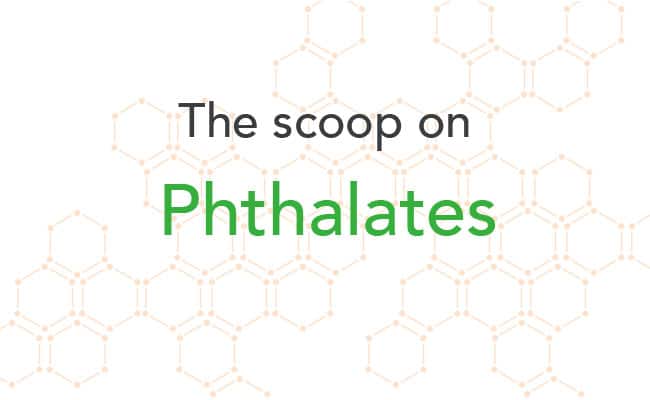
What are phthalates?
Phthalates are a ubiquitous class of chemicals used in softeners, solvents, fragrances, plasticizers, and PVC or polyvinyl chloride products. Phthalates are commonly used to make scents last longer and to make plastics more flexible and resistant to breakage.
What products are phthalates in?
Phthalates are regularly found in fragranced cleaning, cosmetic, and personal care products including skin moisturizers, soaps, shampoos and lotions. They’re used in children’s toys, backpacks, food storage, bottles, food packaging products like cling wrap, medical devices, building materials like vinyl flooring, adhesives, inks, dyes, mosquito repellents and more. They’ve even been found in clothing.
How to tell if a product has phthalates
Phthalates are not listed on ingredient labels. However products that contain “fragrance” on the label commonly contain phthalates. The one word “fragrance” can include more than 100 different chemicals including phthalates. The reason is that manufacturers are not required to disclose the various chemicals that make up a fragrance. This is because fragrances are considered to be “trade secrets“.
Risks associated with phthalates
Phthalates can have long-term health consequences for both adults and children. They can act like hormones in the human body, which can cause a host of heath problems. For example, children with mothers exposed to phthalates during pregnancy were shown to have problems with language development and motor skills. Phthalates have been banned for use in cosmetics in the European Union. Though scientific studies were substantial enough for the European Union to ban their use in cosmetics, this toxic ingredient remains in common use in a variety of products throughout the United States. In January of 2012, Congress banned the use of more than 0.1% of three types of phthalates (DEHP, DBP, and BBP) from children’s toys and childcare products. Three additional types of phthalates (DINP, DIDP, and DnOP) were also banned temporarily. These phthalates, though banned in children’s products, are still widely used in cosmetics. Health risks for phthalates are broad and significant including:
- Cancer – According to The National Toxicology Program, phthalates are “reasonably anticipated to be a human carcinogen”.
- Asthma
- Genital malformations and undescended testes in baby boys
- Reproductive toxicity including lower sperm counts in men
- Childhood obesity
- Birth defects
- Behavioral problems in children
- Premature birth
How to avoid phthalates
Avoid phthalates by avoiding any product listing “fragrance” on the label. Avoid plastic wherever possible, and never heat plastic, for example if you’re using it for food storage. Always hand-wash plastic food containers and cups instead of putting them in the dishwasher where the heat can cause them to leach chemicals. For food storage, consider switching to glass or stainless steel. For baby toys that go into a baby’s mouth, consider wood or food grade silicone instead. Avoid products that contain DEHP, DBP, BBP, DINP, DIDP, and DnOP. Also avoid products that contain DBP and plastics with recycling codes 3, 6, & 7.



